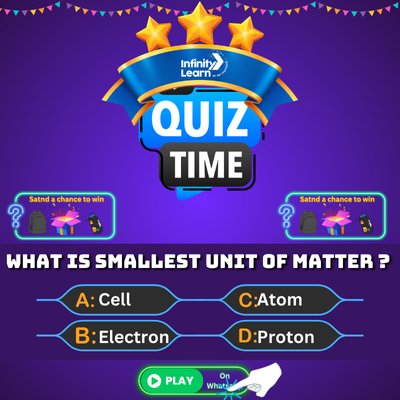Table of Contents
NCERT Solutions for Class 6 Science Chapter 2 Updated for 2025-26
NCERT Solutions for Class 6 Science Chapter 2 helps you comprehend the concepts provided in the NCERT Class 6 Science textbook. Fill in the blanks, true or false and long answer questions and the detailed answers we provide will help you in gaining complete knowledge of the concepts. This NCERT Solutions helps you gain extra knowledge on various aspects of food provided in Chapter 2 of Class 6 Science NCERT textbook. This is a resource material that is recommended by top teachers and students are advised to take advantage of this study material.
Infinty learn brings you NCERT Solutions, designed by our subject experts to facilitate smooth and precise understanding of concepts. These solutions of Class 6 Science have detailed step-by-step explanations of questions given in the NCERT textbooks. NCERT Solutions for Class 6 Science will help you in getting good marks in the examination and also aid you in laying a strong foundation for your future studies as these are aligned with CBSE syllabus. Studying this NCERT Solutions will help you to understand higher-end topics related to food. These solutions provided here will present you information on the major nutrients in our food which includes carbohydrates, proteins, fats, vitamins and minerals, besides, food also contains dietary fibres and water. This chapter also consists of an introduction to vitamins, diseases caused by vitamin deficiency and other nutrients.
NCERT Solutions Class 6 Science Chapter 2 Components Of Food PDF Download
Class 6 Science Chapter 2 Components Of Food NCERT Solutions Question Answer
Here are NCERT class 6 science chapter 2 exercise solutions of NCERT textbook questions:
Section 1: What do different food items contain?
- Which of the following is a main nutrient present in food?
a) Plastic
b) Fibre
c) Protein
d) Wax
Ans: c) Protein - The energy-giving components of food are:
a) Vitamins and minerals
b) Proteins and fats
c) Carbohydrates and fats
d) Water and roughage
Ans: c) Carbohydrates and fats - Which food item is rich in protein?
a) Rice
b) Potato
c) Eggs
d) Sugar
Ans: c) Eggs - Carbohydrates are mainly found in:
a) Fruits and vegetables
b) Butter and oil
c) Pulses and eggs
d) Rice and chapati
Ans: d) Rice and chapati - Which of the following is not a nutrient?
a) Water
b) Carbohydrate
c) Fibre
d) Protein
Ans: c) Fibre
Section 2: Test for Starch, Protein and Fat
- Which reagent is used to test for starch?
a) Copper sulphate
b) Iodine
c) Soap water
d) Vinegar
Ans: b) Iodine - Iodine turns which color in the presence of starch?
a) Yellow
b) Blue-black
c) Green
d) Red
Ans: b) Blue-black - Which two substances are used to test for proteins?
a) Iodine and sugar
b) Water and salt
c) Copper sulphate and caustic soda
d) Soap and lemon
Ans: c) Copper sulphate and caustic soda - Fat can be detected by:
a) Red color formation
b) Paper becoming greasy
c) Blue color change
d) Bubbles in water
Ans: b) Paper becoming greasy - Which test leaves a translucent spot on paper?
a) Test for protein
b) Test for sugar
c) Test for fat
d) Test for starch
Ans: c) Test for fat
Section 3: What do various nutrients do for our body?
- Which nutrient helps in growth and repair of body tissues?
a) Carbohydrates
b) Fats
c) Proteins
d) Vitamins
Ans: c) Proteins - Vitamins are essential for:
a) Energy
b) Growth of bones
c) Protection from diseases
d) Hair growth only
Ans: c) Protection from diseases - Which vitamin is obtained from sunlight?
a) Vitamin A
b) Vitamin B
c) Vitamin D
d) Vitamin K
Ans: c) Vitamin D - Minerals like calcium and iron help in:
a) Bone and blood health
b) Giving energy
c) Digesting food
d) Killing germs
Ans: a) Bone and blood health - Which nutrient acts as a body coolant and helps digestion?
a) Fats
b) Water
c) Vitamins
d) Sugar
Ans: b) Water
Section 4: Balanced Diet
- A balanced diet contains:
a) Only carbohydrates
b) All nutrients in the right amount
c) Only fats and proteins
d) Water and salt only
Ans: b) All nutrients in the right amount - Which of the following is a good source of balanced diet?
a) Only rice and dal
b) Only butter and sugar
c) Fruits, vegetables, grains, and milk
d) Fried food and soft drinks
Ans: c) Fruits, vegetables, grains, and milk - Eating too much junk food may lead to:
a) Growth in height
b) Nutrient deficiency
c) Strong bones
d) More energy
Ans: b) Nutrient deficiency - Which of the following is an energy-giving and also protective food?
a) Ghee
b) Butter
c) Fruits
d) Ice cream
Ans: c) Fruits - Which of these food items should be limited for a healthy diet?
a) Fresh fruits
b) Leafy vegetables
c) Sweets and oily snacks
d) Grains and pulses
Ans: c) Sweets and oily snacks
Section 5: Deficiency Diseases
- Deficiency of Vitamin A causes:
a) Night blindness
b) Scurvy
c) Rickets
d) Beriberi
Ans: a) Night blindness - Lack of Vitamin C in diet leads to:
a) Weak bones
b) Scurvy
c) Anemia
d) Swollen joints
Ans: b) Scurvy - Rickets is caused by the deficiency of:
a) Vitamin A
b) Iron
c) Vitamin D
d) Vitamin B
Ans: c) Vitamin D - Which mineral is important to avoid anemia?
a) Calcium
b) Phosphorus
c) Iron
d) Iodine
Ans: c) Iron - Deficiency of iodine causes:
a) Diabetes
b) Goitre
c) Night blindness
d) Kwashiorkor
Ans: b) Goitre
Section 6: Roughage and Water
- Roughage in food helps in:
a) Making bones strong
b) Digesting fat
c) Proper bowel movement
d) Building muscles
Ans: c) Proper bowel movement - Which of the following contains roughage?
a) Cheese
b) Butter
c) Green vegetables
d) Soft drinks
Ans: c) Green vegetables - Water helps in:
a) Providing proteins
b) Regulating body temperature
c) Building muscles
d) Creating blood cells
Ans: b) Regulating body temperature - Lack of water in the body may lead to:
a) Fever
b) Weak eyesight
c) Dehydration
d) Joint pain
Ans: c) Dehydration - Which food item is best for both hydration and digestion?
a) Chips
b) Fried rice
c) Cucumber
d) Cheese
Ans: c) Cucumber
Also Check Related Links
- Chapter 1 Food: Where Does It Come From?
- Chapter 2 Components of Food
- Chapter 3 Fibre to Fabric
- Chapter 4 Sorting Materials Into Groups
- Chapter 5 Separation of Substances
- Chapter 6 Changes Around Us
- Chapter 7 Getting to Know Plants
- Chapter 8 Body Movements
- Chapter 9 The Living Organisms and Their Surroundings
- Chapter 10 Motion and Measurement of Distances
- Chapter 11 Light, Shadows, and Reflection
- Chapter 12 Electricity and Circuits
- Chapter 13 Fun with Magnets
- Chapter 14 Water
- Chapter 15 Air Around Us
- Chapter 16 Garbage In, Garbage Out
Class 6 NCERT Solutions for Science Chapter 2 Components of Food Overview
The CBSE Class 6 NCERT Solutions for Science Chapter 2, “Components of Food,” align with the syllabus and textbook. They offer detailed explanations and answers to questions on the major nutrients found in food, such as carbohydrates, proteins, fats, vitamins, and minerals. These solutions help students understand the functions of each nutrient and identify foods rich in them.
Additionally, the solutions discuss the significance of a balanced diet, deficiency diseases, and the consequences of excessive or insufficient intake of certain nutrients. Emphasizing the importance of a balanced diet, the chapter recommends a variety of food items to meet the body’s nutritional needs.
Prepared by experts, the NCERT Solutions for Class 6 Science Chapter 2 are accurate and easy to comprehend. Students can utilize these solutions to efficiently complete their homework and prepare for exams, ensuring a clear understanding of the concepts related to food components.
Important Topics Covered in NCERT Solutions for Class 6 Science Chapter 2 Components of Food
- What do different Food Items Contain?
- Test for Starch
- Test for Protein
- Test for Fats
- What do Various Nutrients do for Our Body?
- Balanced Diet
- Deficiency Diseases
At Infinty learn, you can get access and download NCERT textbooks, notes, syllabus, NCERT Solutions, NCERT Exemplar solution, sample papers and question papers of all the classes and subjects of CBSE syllabus. For more information, download the Infinty learn Learning App.
| Other Resources for Class 6 | |
| Worksheet for Class 6 All subjects | CBSE Notes Class 6 |
| NCERT Books for Class 6 | Online Tuition for Class 6 |
FAQs on NCERT Solutions for Class 6 Science Chapter 2
What are the components of food in Class 6?
The components of food in Class 6 include carbohydrates, proteins, fats, vitamins, minerals, and roughage. Carbohydrates and fats provide energy, proteins help in body-building, vitamins and minerals are essential for growth and body functions, and roughage aids in digestion and prevents constipation.
What are the sources of food in Class 6?
The sources of food in Class 6 are plants and animals. Plants provide fruits, vegetables, cereals, pulses, nuts, and some beverages like tea and coffee. Animals provide milk, eggs, meat, and fish. Some food items come from both plants and animals, such as honey.
Why do we need substance separation in Class 6?
Substance separation is necessary in Class 6 because it helps in obtaining pure substances from a mixture. This is important in various industries for the production of goods and services. Separation methods are also used in recycling and reusing materials, which helps in reducing waste and conserving resources. Additionally, substance separation is crucial for environmental protection and public health, as it helps in separating waste and pollutants from the environment.
What are the important topics covered in Chapter 2 of NCERT Solutions for Class 6 Science?
The important topics covered in Chapter 2 of NCERT Solutions for Class 6 Science include: What do different food items contain, tests for starch, protein, and fats, the role of various nutrients in our body, balanced diet, and deficiency diseases.
How many questions are present in Chapter 2 of NCERT Solutions for Class 6 Science?
There are about 5 questions with many subquestions present in Chapter 2 of NCERT Solutions for Class 6 Science. The solutions provided by Infinty learn help students understand and answer these questions effectively, improving their logical thinking abilities and exam performance.
How to prepare Chapter 2 of NCERT Solutions for Class 6 Science for the exam?
To prepare Chapter 2 of NCERT Solutions for Class 6 Science, students can refer to the solutions provided by Infinty learn. These solutions focus on important points, helping students get a clear understanding of the chapter. The solutions are designed to be concise and easy to understand, aiding in efficient memorization and revision. Additionally, the solutions are available in a downloadable PDF format, allowing students to access them anytime and anywhere. The simple language used in the solutions enhances students' analytical and logical thinking abilities, which are essential for the exam.








